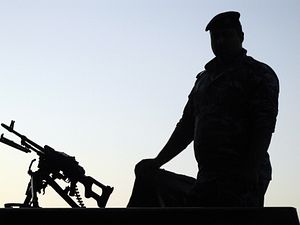Central Asia has not been an area of interest for ISIS and Central Asians haven’t been overly interested in ISIS either, according to a recently released report from by the Polish Institute of International Affairs (PISM). The report’s authors take a comparative approach, examining the region’s five states against the Middle East and Europe, which currently supply the most foreign fighters to ISIS.
“If poverty, political repression, political marginalisation, poor governance and corruption, undoubtedly present in Central Asia,” the report notes, “are to pave the way for the appearance of ISIS in a given country then we should look at how these factors influence the decisions of Europeans and the inhabitants of MENA who are quite eager to travel to Iraq and Syria.”
“Central Asia seems not to be the world’s preeminent place for recruits for terrorism—either domestically or internationally,” the report comments. While estimates range–sometimes wildly–per capita Central Asia seems to send far fewer fighters to Iraq and Syria than the countries of MENA or Europe. Only 1 in 40,000 from Tajikistan have joined ISIS, while 1 in 23,800 from Belgium have. Keep in mind, there are far fewer Muslims in Belgium than Tajikistan, which is 90 percent Muslim and 85 percent Sunni.
The states of Central Asia are often categorized as vulnerable to radicalization, weaknesses in political and social systems “marked by authoritarianism, corruption, nepotism, and ethnic and religious tension, as well as their poor economic circumstances” are critical. Nonetheless, “interest in ISIS among their citizens remains low.”
Distance and poverty are two reasons. The report notes that “rarely do we see direct travel between a given country [in Central Asia and the battlefields of the Middle East.” Most Central Asian recruits travel from either Russia or Turkey. But European capitals are equally far from the battlefield yet provide much higher percentages of recruits. The link between poverty and terrorism is noticeably tenuous in the report’s analysis, which notes that “one can hardly expect impoverished local populations to afford long distance travel.” The states of MENA and Europe where most ISIS foreign fighters are recruited are markedly richer than the states of Central Asia.
In addition, “ISIS is highly unlikely to mobilise Central Asians along the lines of its conflict with the ‘rejectionist’ and treacherous Shiites.” Although Central Asia is mostly Sunni, the region’s Muslims have been far less likely to endorse pan-Islamic causes in the past, and regional tensions are seldom linked to the Sunni-Shia divide which permeates conflicts in the Middle East.
The PISM report highlights case studies from each of the five states to illustrate the data it gathered in context. In these sections it becomes clear that those Central Asians who have joined ISIS are motivated by social and economic exclusion. For example, government sources in Kyrgyzstan say that most of the Kyrgyz who have joined ISIS are of the Uzbek minority–which is subject to economic and social exclusion within the Kyrgyz state. It is not so much poverty itself that provides motivation, but inequality.
The vulnerability of Tajiks to recruitment is strongly connected with their exclusion both in Russia and their homeland (caused by the fact that since they are forced to work abroad they are no longer part of the society in their homeland, and simultaneously, they are not accepted as part of the society in the host country, either)…
For its part, ISIS isn’t terribly concerned with Central Asia either. “ISIS has devoted a far from overwhelming amount of attention to Central Asia” and the idea of a “Khorasan province,” centered in Afghanistan and Pakistan, “plays a very distant fiddle to mentions of the struggle with Saudi Arabia, Egypt, Iraq, Syria, Libya, Algeria, Tunisia and also different Western or European countries in ISIS’ strategic communications and its geopolitical interests.” ISIS has largely ignored the Islamic Movement of Uzbekistan’s reported declaration of support.
The greatest threat, perhaps, to the region is not necessarily ISIS but the Caucasian networks which radicalize and recruit Central Asians working in Russia. These networks can just as easy turn fighters back into Central Asia, and “such returns or any sign of domestic radicalisation will be used by the local repressive authorities to ask for more Russian assistance in combating the threat, and as a pretext to limit civil liberties even further.”
The report’s recommendations note that “purely security-oriented measures… will not suffice for the Central Asian states to prevent an internal surge in ISIS popularity” and that authorities should prioritize economic and regional development, capitalizing on EU initiatives, for example, focused on “fostering economic cooperation, the rule of law and human rights in the region.”
































